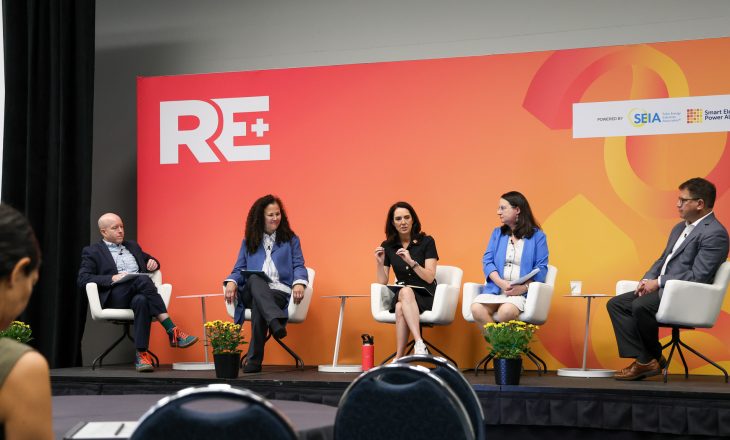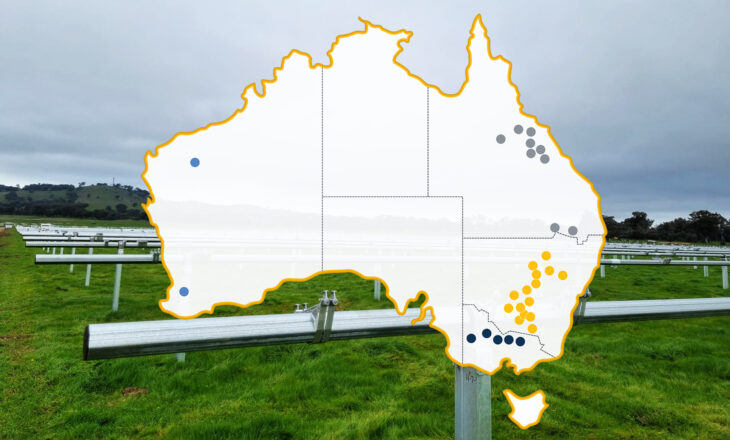
Recently, I participated in a webinar on the future of the utility-scale solar industry with Sylvia Leyva Martinez, senior analyst at Wood Mackenzie, and Art Del Rio, VP of strategic procurement at EDF Renewables. In it, we discussed current industry topics for utility solar developers, owners and operators, and technology manufacturers.
It was such a great conversation. You can watch the full webinar embedded below or keep reading for some key takeaways from our discussion, including:
- recent changes in U.S. policy concerning utility-scale solar,
- guidance needed to unleash progress,
- thoughts on module availability,
- future of solar development,
- challenges surrounding severe weather, and
- some great questions from attendees.
Recent changes in U.S. policy concerning utility solar
The passing of the Inflation Reduction Act (IRA) will help stabilize supply chain issues over the long run, creating increased optimism in developers and financiers.
Wood Mackenzie reported a 29% decrease year over year in deployment of utility-scale solar from 2021 to 2022.
Sylvia shared that two reasons for this are:
- The Uyghur Forced Labor Prevention Act (UFLPA)
- Start of an anti-circumvention investigation by the US Department of Commerce
These factors led to several gigawatts (GW) of modules being detained by Customs and Border Protection, and many projects were pushed to 2022 and 2023. These factors will continue to affect the industry in the short term, but analysts at Wood Mackenzie are confident they will work out in the long term.
Further guidance needed to unleash progress
Developers are trying to choose between the Production Tax Credit (PTC) and Investment Tax Credit (ITC) tax credit transferability, among other variables. Like how steel will be treated under the ITC, or what qualifies as “domestic source” for different materials, to name a few. Knowing which variables—or combination of variables—can be implemented can change each site’s projected revenues.
That’s why federal entities need to provide further guidance on various requirements. This guidance will help even out the supply-and-demand imbalance and fill in tax planning gaps for financing solar projects.
Thoughts on module availability
As suppliers fall in line with UFLPA compliance, production should ramp up this year or early in 2024. This will help stabilize the supply-and-demand imbalance.
Customers must look at designs with multiple modules because they can’t secure modules, or the modules may fall through. It’s been a challenge from a project timing perspective.
From a design and planning perspective, ARRAY works with customers who ask us to model around different module types because it’s possible they’ll get partials, or the modules may change.
We’ve seen demand for this kind of design go up exponentially. So, we’ve automated the way we do our designs to keep up with customer needs while ensuring the same quality of review for each design.
One ARRAY DuraTrack® advantage is that it’s fully module agnostic. By not predrilling holes in the tracker torque tube, it’s able to fit any specific module currently on the market. This allows us to confidently design around multiple modules knowing that the core bill of materials for the tracker won’t change.
Future of solar development: a prediction for next 3–5 years
From a developer’s standpoint, there’s no shortage of off-taker customers, but projects in ideal locations with flat, even land in mostly sunny places are less available. We need to continue to find cost-effective solutions to deal with ever-more-challenging terrain and subsurface conditions including the introduction of our new flexible terrain tracker, the ARRAY OmniTrack™️.
This new tracker allows one degree more flexibility in the north-south slope change with the torque tube. That allows our customers to cut down on costly grading and maintains the site’s natural foliage for a less invasive installation.
At ARRAY, we’re continuing to prioritize lower lead times and consistent deliveries for customers. We’ve expanded and locked in our logistics carrier and have alternatives in place if congestion issues arise.
We’ve expanded our supply base with multiple options, so we’re not relying on a single source. Not only are we able to do some of the manufacturing in-house, but we have manufacturing and suppliers around the world. Our global supply plan is essential to our ability to respond quickly to the unexpected.
Challenges surrounding severe weather
Large hail and 50-year winds are occurring more frequently, causing problems with the insurability of many sites. The entire industry needs to address this reality and develop technological solutions rather than addressing it through insurance alone.
Where other tracker companies fall short is that they rely on a lower angle degree stow position for wind, which is not necessarily best for hail. ARRAY’s wind mitigation position occurs at the highest tilt level, 52°, which is also optimal for hail. Using ARRAY SmarTrack™️ software, this mitigation can happen remotely or manually to help protect our customer’s sites.
For projects in the North and Midwest U.S. regions, our SmarTrack system also has an active stow response in case of snow. It detects snow and moves to 52°. Once enough snow melts, it moves the tracker back to normal tracking with no damage to the modules.
Audience Question:
For tracker evaluation, have the operation and maintenance (O&M) needs been considered when comparing them to fixed-tilt racking?
Art shared that 15 years ago, EDF was nervous about trackers because of the O&M component. Now, most of EDF’s sites use trackers, and two of the reasons include:
- trackers have led to better production, and
- the ability to move and stow trackers during severe weather far outweighs any potential O&M costs.
Our goal with DuraTrack is zero maintenance. This includes design features like sealed gear boxes that don’t require lubrication and parts that are tested for the lifetime of the site. With their improved reliability, increased throughput, and the low cost of ownership of trackers, our trackers are more advantageous compared to fixed-tilt systems even in the kilowatt range.
ARRAY’s perspective on the Inflation Reduction Act (IRA) and the future
As Sylvia said during the webinar, “The panorama looks bright for solar despite the challenges around needing clarity from the IRS.”
The IRA is intended to drive interest in renewables—solar in particular—and create more U.S. jobs. So, it’s a good thing, but it’s complicated to navigate right now.
Creating a U.S.-based supply chain from scratch has been challenging for many companies. Thankfully, at ARRAY, we’ve been building our strong U.S. supply chain for 30+ years, which reduces risk for developers.
However, the government still needs to provide information on what is required for traceability to the entire industry. With that understanding, we can help customers and capitalize maximally on Solar Investment Tax Credit (ITC) benefits.
Overall, it’s an exciting time but also challenging. Everyone is ready to go and waiting for that starter pistol of clarity to go off.
Sign up below and be the first to know about ARRAY’s next webinar!




